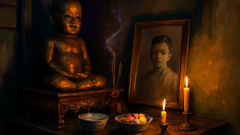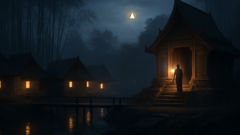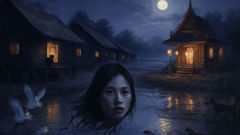Introduction
Across the rolling, emerald hills of Waterford, where the mist clings to the earth and ancient trees stand like silent witnesses, the people whisper of shadows that move with intent. Here, in the heart of medieval Ireland, stories are not merely told; they are lived, their echoes woven into the stones of crumbling castles and the reeds that sway along moonlit rivers. Among these tales, none chills the marrow like the legend of the Dearg Due—the Red Bloodsucker. She is a specter born of sorrow and injustice, her origins entangled with love as much as with vengeance, and her name spoken with a shudder in hushed voices by firelight. To understand the Dearg Due is to step into an Ireland where the line between the living and the dead was as thin as a breath, and grief had the power to unearth horrors from the grave. The land itself seems complicit in her haunting, draping itself in fog and silence when night falls, hiding secrets beneath its heather and stone. It was here that a beautiful young woman, with hair bright as autumn leaves and eyes reflecting the blue-grey sky after rain, lived and suffered. Her tale is a mirror to the world she inhabited: beautiful yet brutal, filled with longing and loss, with passions that refused to die. This is her story—a legend that begins with a promise of love but ends with a curse that bleeds through generations, painting Ireland’s past with strokes of crimson fear.
A Beauty in the Shadow of Sorrow
In the heart of medieval Waterford, where the River Suir wound through fields patchworked with wildflowers and grazing sheep, there was a village both ordinary and remarkable. Its stone cottages leaned into one another for warmth against the Atlantic winds, and the villagers clung to their traditions as fiercely as to their loved ones. At the edge of this village, beyond a hedge of hawthorn and bramble, lived a young woman named Ailbhe, whose beauty was as renowned as her gentle spirit.
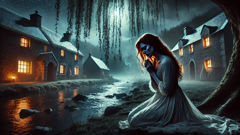
Ailbhe’s hair was a cascade of copper, catching the sun and setting it aflame, and her eyes held the stormy blue of the Irish sea. But it wasn’t her looks alone that set her apart; it was the kindness she showed to all, whether tending her ailing mother, gathering herbs for neighbors, or singing to children beneath the willow by the ford. The villagers adored her, and there were few young men who did not dream of winning her heart. Among them was Pádraig, a thatcher’s son with laughter in his eyes and a poet’s tongue, whose devotion to Ailbhe was as constant as the turning tides.
Yet happiness in those days was fragile, easily shattered by the ambitions of the powerful. Word of Ailbhe’s beauty traveled beyond the village, catching the ear of Lord Dubhán, whose castle loomed on a nearby hill. Dubhán was wealthy and cruel, a man used to taking what he desired. When he came to the village with a retinue of armored men, offering Ailbhe’s father gold and land for her hand in marriage, there was little hope of refusal. Her father, weakened by debt and the loss of his wife, bowed his head and accepted, sealing his daughter’s fate with a trembling signature. Pádraig pleaded with Ailbhe to run away with him, to seek freedom in the wilds, but Ailbhe’s sense of duty to her family outweighed her dreams. On the night before her wedding, she wept beneath the willow tree, her tears silver in the moonlight, promising Pádraig that her heart would always be his, no matter what dawn brought.
The marriage was a spectacle of riches and sorrow. Ailbhe was led from her humble home in a gown of white and gold, her eyes hollow and her lips silent. Lord Dubhán, reveling in his conquest, paraded her before his court as a trophy. The days that followed were marked by coldness and cruelty. Dubhán kept Ailbhe locked away in his stone manor, jealously guarding her beauty from the world. He lavished her with jewels she never wore and silks she never touched, but starved her of affection and kindness. Ailbhe’s world shrank to a handful of rooms, her only solace the sliver of sky she could glimpse from a high, barred window.
The villagers, helpless to aid her, spoke her name in prayers and left offerings at the crossroads, hoping to appease the old spirits. Pádraig, forbidden even to see her, haunted the woods, his songs turning mournful and wild. As months wore on, Ailbhe’s light faded. She became a wraith in her own home—pale, silent, and shadowed by grief. When her father died, broken by guilt and illness, she was not permitted to leave the manor to mourn him. Her sorrow deepened into a bitterness that festered within her heart, turning love into anguish and hope into something darker.
On a night when the moon was high and the wind howled like a banshee, Ailbhe was found dead in her chamber. Some said it was heartbreak, others whispered of poison or madness. Lord Dubhán buried her quickly in unconsecrated ground beyond the village, more concerned with ridding himself of her memory than honoring her spirit. He forbade mourning, and soon enough, another woman took Ailbhe’s place in the manor. The world moved on, but the wound in the land and in Pádraig’s heart did not heal. The night after her burial, a cold mist settled over the fields, thicker and heavier than ever before. The village dogs howled, cattle refused to graze, and a sense of foreboding seeped through the air like fog rolling in from the sea. It was then, in the restless silence before dawn, that the legend began—a legend born of injustice, sorrow, and an unquiet grave.
The First Night: The Blood Moon Rises
The night of Ailbhe’s burial was like none the villagers had ever known. The moon rose swollen and red, casting an eerie glow across the fields, as if the sky itself was mourning. In the hour between midnight and dawn, an unnatural stillness blanketed the land. Not a single owl hooted, nor did the foxes bark. Only the wind moved, rustling the dead leaves as it circled Ailbhe’s grave.

It was Pádraig who first saw her return. Drawn by a dream—or perhaps a voice whispering in his ear—he wandered into the fields just before dawn. There, at the edge of the old yew grove, he saw a pale figure rising from the earth. At first, he thought he was seeing a ghost, but as he crept closer, he realized she was not a specter but something altogether more haunting. Ailbhe stood before him, her hair wild and tangled, her skin white as chalk except for her lips, which were as red as blood. Her eyes glowed with a hunger that was not her own. She beckoned to Pádraig with a hand trembling between longing and fury.
He stepped forward, his grief blinding him to all sense. "Ailbhe?" he whispered, voice breaking. She smiled—a smile that twisted sorrow and seduction into something both terrifying and irresistible. Pádraig fell into her arms, and for a moment, all the pain vanished. Then, as the moonlight glinted off her sharp teeth, she pressed her lips to his neck. The pain was swift and cold. Pádraig’s world faded to black. When he awoke, the sun was rising, and he lay alone among the yews, weak and shivering, his memory clouded but his neck bearing two crimson marks. He stumbled home, changed forever.
The villagers soon noticed a change in the air. Men grew pale and listless; children awoke screaming from nightmares of a red-haired woman beckoning them into the night. Livestock sickened and died; milk soured in the pail. Some spoke openly of a curse, others whispered about Ailbhe’s restless spirit. Only the oldest among them, wise in the ways of old Ireland, dared name her: Dearg Due—the Red Bloodsucker.
Dearg Due was not like the vampires of foreign lands; she was a creature born of heartbreak and wronged innocence. By day, she lay in her grave, unable to rest. By night, she wandered the fields and village, searching for warmth to fill the cold void inside her. She appeared beautiful still, but her beauty had become a weapon—drawing young men from their beds and into her deadly embrace. Those she visited were found pale and empty, their blood drained and their eyes wide with terror and longing. Fear gripped the village. Doors were barred and windows shuttered. Priests were summoned to bless the fields, but their prayers seemed to float away on the wind. Only Pádraig knew the truth of what walked among them, but shame and sorrow held his tongue.
One night, unable to bear his burden, Pádraig followed the trail of cold air that led from his cottage toward Ailbhe’s grave. He found her there, kneeling among the yews, weeping blood. She begged him to forgive her, to remember the love they once shared. Her voice was soft as falling leaves, but beneath it ran a hunger she could not deny. "I did not choose this," she whispered. "But I cannot stop." Pádraig took her hand and promised to help her find peace—no matter the cost. Together, they devised a plan rooted in old magic: to trap her spirit beneath a cairn of stones laced with hawthorn and ash, so she could harm no one else. With trembling hands and hearts heavy with regret, they gathered stones from the riverbank and branches from the sacred trees. On the night of the next blood moon, Pádraig sealed Ailbhe’s grave with a heavy cairn, whispering prayers for her soul and his own. For a time, the village knew peace. The fields blossomed anew, and laughter returned to the cottages. But the memory of the Dearg Due lingered, haunting dreams and stories by firelight. And beneath the cairn, Ailbhe waited—her hunger growing with each passing year.
Centuries of Shadows: The Curse Endures
Years passed, then decades. The village changed as all things do: new cottages rose where old ones fell, and fields once wild were tamed for barley and flax. Yet the legend of the Dearg Due clung to Waterford like ivy to ancient stone. Every generation told the story—sometimes in whispers to frighten children, sometimes with tears to mourn lost love. No one dared disturb Ailbhe’s grave. The cairn of stones and hawthorn became overgrown, yet villagers still left offerings at its edge: milk for peace, salt for protection, and handfuls of primroses for remembrance.
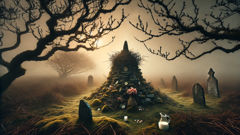
But curses do not sleep forever. On a night when the moon hung low and red over the hills—a night much like the first—the wind shifted. A hunting party from a distant town, emboldened by drink and tales of buried treasure, stumbled upon the old cairn. Unaware of its purpose, they dismantled the stones in search of gold. The final branch of hawthorn snapped with a sound like a scream, and a cold wind roared from the earth. The next morning, one of the men was found pale and lifeless among the yews, his blood drained and his mouth frozen in terror. The village awoke to find the curse renewed.
Word spread quickly that the Dearg Due had risen again. Men were warned to stay indoors after sundown; women hung crosses and wild garlic at their doors. Yet it seemed nothing could stop Ailbhe’s restless spirit. She haunted the roads and fields, drawn to those who bore even a spark of desire or grief. Some said she could not cross running water; others claimed she could only be repelled by hawthorn or a pure heart. But each new attempt to end her curse failed. Sometimes, she was glimpsed weeping at her own grave; other times, dancing on the edge of moonlit meadows, red hair streaming behind her like a banner of fire.
As the years turned to centuries, Ailbhe’s story spread beyond Waterford. Wandering bards wove her legend into song; monks recorded her curse in ink and vellum. She became a warning against betrayal and cruelty, but also a symbol of love that refuses to die—even when it should. Some said that when the blood moon rises and mist cloaks the fields, you can still hear her voice on the wind: a song of longing, sorrow, and vengeance.
The villagers adapted, their customs shaped by fear and memory. On certain nights, they gathered at the cairn, lighting candles and singing old songs to honor Ailbhe’s soul and beg forgiveness for the wrongs done to her. They taught their children never to stray too far after dusk, never to speak ill of the dead, and always to respect the power of love and sorrow. The land itself seemed marked by her story—places where wild roses grew redder, where the grass would not grow, or where a sudden chill would fall even on a summer night.
Yet for all their precautions, the Dearg Due was never truly banished. She remained—a shadow in the moonlight, a beauty turned to terror, a lover lost to vengeance. Her legend endured, whispered by wind and water, woven into the very fabric of Ireland.
Conclusion
Even as centuries pass and Ireland changes, the legend of the Dearg Due endures—whispered in smoky taverns and echoing through the countryside on misty nights. She is more than a warning; she is a reflection of wounds that never quite heal: love betrayed, innocence lost, sorrow denied peace. Her tale is a reminder that hearts broken by cruelty can sometimes birth monsters, and that justice denied in life may seek its own redress from beyond the grave. In Waterford and beyond, locals still avert their eyes when the blood moon rises and winds howl through yew groves. They say her beauty is as potent as ever—a siren call for those who wander lonely roads or let longing fester too long. And so, while hawthorn branches may bar her grave and new generations may try to forget, Ailbhe’s story lingers like a chill in the marrow. To this day, the Dearg Due’s legend invites us to remember: every act of kindness or cruelty ripples through time, and love—when twisted by grief—can haunt us longer than any ghost.





